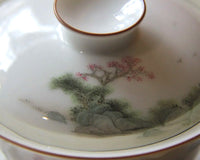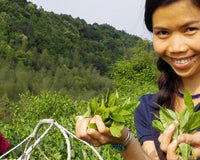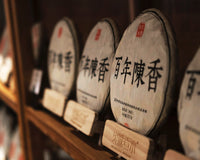Whereas white teas were previously produced almost solely for export, it is now an increasingly important part of the domestic tea market. Production is centred around two main areas, both located in Fujian: Zhenghe and Fuding. There are sufficient differences in climate, local terroir, production method and cultivars used, to talk of two different styles of white teas: Northern and Eastern.
Fuding and Zhenghe
Northern-style white teas are centred around the county of Zhenghe, a highly-forested mountainous region that rests on the borders of two mountain chains, one of which is Wuyi.
Eastern-style white teas are located closer to the sea, amidst a different mountain chain surrounding the town of Fuding. To the east the land drops to sea level, creating a distinctive horseshoe-shaped landscape. Unlike the inland climate of Zhenghe, which has very cold winters and hot summers, Fuding experiences a milder, wetter maritime-influenced climate, with a less extreme temperature range.

Map of Northern Fujian showing Fuding on the right and Zhenghe on the left. (Courtesy of Google Maps)
Traditionally, tea-makers in Zhenghe favoured the use of indoor withering and shaded drying, followed by baking at a relatively low temperature. Whereas in Fuding the 'interval method' of withering is often used; long periods of indoor withering are punctuated by short bursts of open air sun-drying.
Fuding is also known for its ongoing experimentation with production methods: adding rolling, shaking and higher baking temperatures to create 'New Concept' white teas. Currently, Fuding accounts for around two-thirds of China's white tea, whereas Zhenghe represents around one-fifth.[1]
White teas from Fuding are known for their sparkling, white leaves which result from the thicker, denser coating of fine, silver hairs ('down') found on premium grades. Liquors are slightly thinner than those of Zhenghe, which appear greener and have a less emphatic silver gloss, but are prized for thicker 'mouthfeel' and better infusion rates.
There are notable physical and chemical differences between the two main cultivars used in Zhenghe and Fuding. The traditional cultivars for Zhenghe white tea are larger-leafed and contain higher levels of polyphenols than those of Fuding (which helps to explain the thicker mouthfeel). The longer, thicker white down of the Fuding cultivars possess notably higher volumes of amino acids, contributing to the pronounced briskness and 'downy' aroma of white teas from that area.

政和大白 Zhenghe Da Bai white tea varietal. (Image courtesy of www.e-chinatea.cn)
Six main Fujian white tea cultivars
- Zhenghe Big White 政和大白 or 政和大 (traditional cultivar for Zhenghe teas)
- Fu'an Big White 福安大白
- Fuding Big White 福鼎大白 (traditional cultivar for Fuding teas)
- Fuding Large Down 福鼎大毫
- Fuyun No. 6 福云六号
- Shui Xian White or White Narcissus 水仙白











